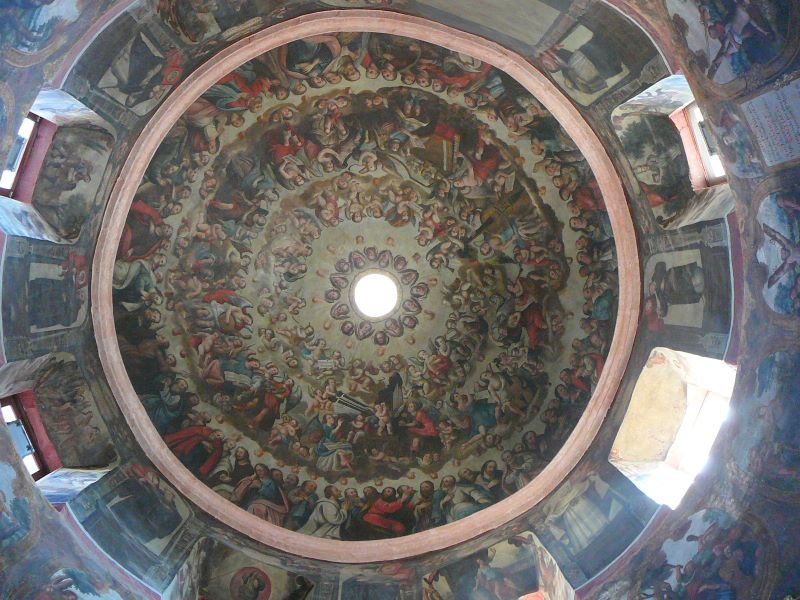
Located about 7 miles north of San Miguel de Allende, the Shrine of Atotonilco is a folk art jewel --and still a functioning shrine attracting thousands of penitents per year, segregated by sex, united in the desire for penitence. The once sprawling complex was created through the efforts of San Miguel's most famous priest, mystic, and soon-to-be poet, Luis Felipe Neri de Alfaro (1709-1776). His vision was to replace a "sinful" mineral bath area with a house of retreat and repentance.
As a young priest in San Miguel, Alfaro had spent his inheritance adding a chapel (see La Salud pages) to the local college in that town. With great faith, he and native craftsmen began building the shrine, hoping that miracles would provide just-in-time financing. Alfaro later insisted that an angel disguised as a nobleman (aren't they all?) made a substantial contribution one time. [99] After 8 years of such miracles, the church with massive stone walls rose in the desert.
Above: the west entrance area decorated for the Christmas season. The south entrance (once a cemetery) is reserved for those making week-long retreats.16]
Starting in 1740 when he was 31, Alfaro and his crews of "volunteers" completed the Sanctuary in 8 years. Alfaro lived here the rest of his life, adding various types of religious self-torture to his already abstemious life.
See more pictures of the exterior of this shrine by clicking here.
Bleeding from the whip, the thorn-crowned statute of The Lord of the Column
Upon entering the shrine, one sees the granddaddy of all toted icons in San Miguel: The 1823 La Milagrosa Imagen del Senor de la Columna or the Miraculous Image of The Lord of The Column. San Miguel's Holy Week activities start (two weeks before Easter) by carrying this statue of Christ from Atotonilco into San Miguel. Candles in hand, thousands make this overnight journey and today modern blogs recount this traditional trip. In Father Alfaro's day (or night), he would carry a cross into town himself and pay people to trip him, driving his crown of thorns deeper into his flesh. Today this procession starts two weeks before Easter, starting at Saturday midnight at Atotonilco, pausing for mass at 3AM, then on to San Juan church in San Miguel where it rests until Good Friday when it is carried to the Parroquia.[89]
True to form, Alfaro, by then sleeping in a coffin[59] , died on Good Friday, 1776. The right side of the nave houses his remains not too far from the statue shown above. To a large extent, the somber processions and other rituals marking San Miguel's Holy Week are Alfaro's legacy -- along with this extraordinary Shrine.
But the statues are not what draws the eye when visitors enter this shrine. The interior is covered with a religious graphic novel based upon The Passion of Christ. Devotions were put into text by none other than the mystic poet Padre Alfaro. Most paintings are by the folk artist Miguel Antonio Martinez de Pocasangre [100] with a few by Jose Maria Barajas.[7]
Here's a typical presentation -- Father Alfaro's verse, more passion than poetry, framed by Martinez de Pocasangre's murals. If comic books can be called graphic novels, then Atotonilco is a Graphic Sistine Chapel.
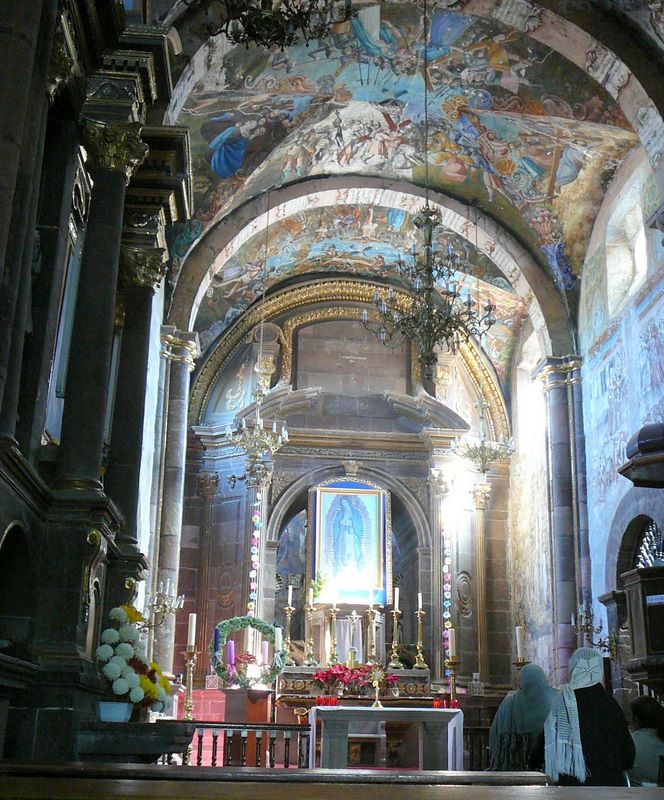
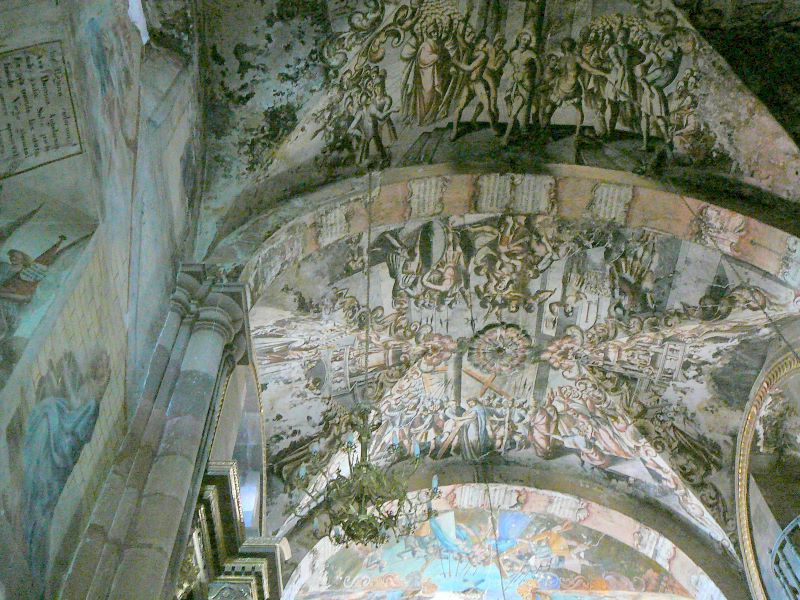
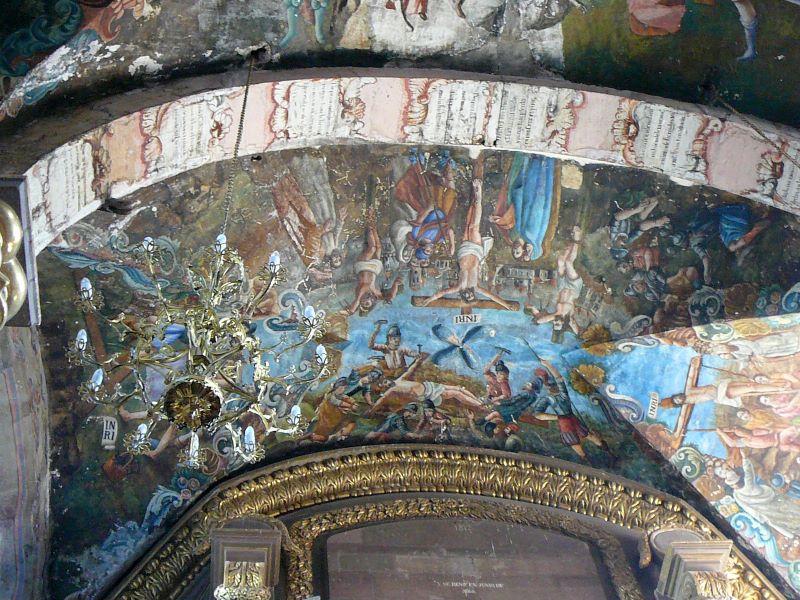
The vestibule ceiling showing the capture of Christ
While the church is dark (both from a lack of sunlight and an obsession with the Passion of Christ), the entrance vestibule is sunlit and introduces the combination of the Art Naive poetry/folk art that fills most of the shrine's interior. (Subsequent restorations removed most of the murals on the exterior walls.) The vestibule ceiling begins telling the story of The Passion, starting with Holy Thursday in Gethsemane and proceeding in clockwise order:
The kiss of Jude with a Monkey on his back
The content is dark but the painting is light: Here's one segment of the mural showing the red-robed Judas kissing (and identifying) Christ in front of the Roman Soldiers who are dressed a bit like the Spanish Conquistadors. The monkey on Judas' back is, of course, Satan. The man at 9 O'clock position with the upraised sword is...
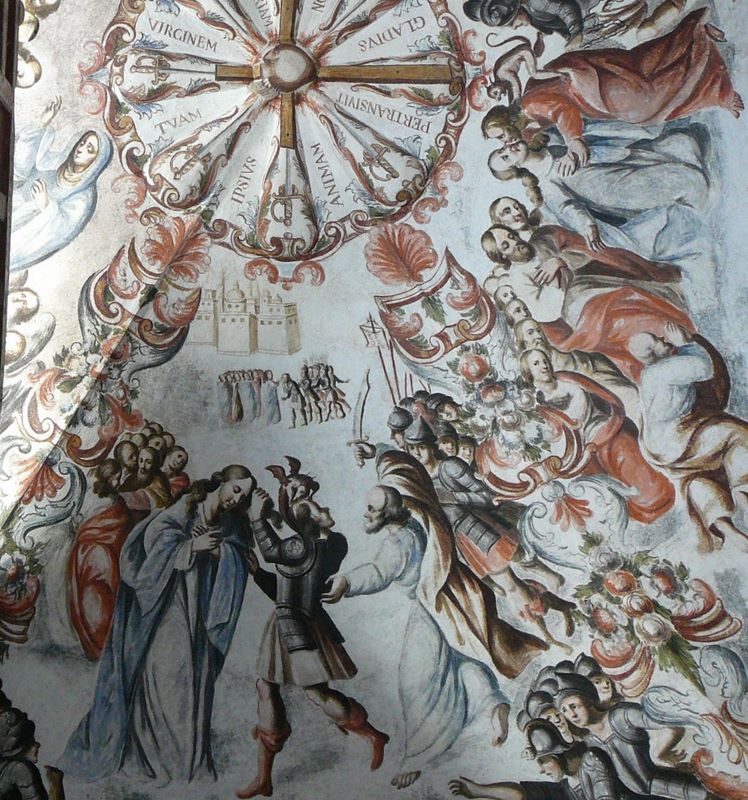
...this somewhat blurry close-up is of a man dying while the devils await his last breath in order to escort him to hell. Perhaps a message to those who come to Atotonilco for fun at the springs instead of the whips of the retreat.
Just to the left after passing through the vestibule are
two chapels. The first (see left picture below) is
empty of furniture but lavish in its decorations (Note the
wallpaper-like mural above the first arch). The empty
space leads the eye to the Calvary scene beyond.
Click on either picture to see it enlarged.
A
reliquary appears above a red
cloth and diamond necklace. (Click here to see this enlarged.)
|
|
|
| Foreground: the Chapel of the Holy Sepulcher... | ...leading to the Calvary Chapel |
The Calvary chapel is the largest in the church providing ample space for three altars with wood polychromatic statues of the Passion. Unfortunately the chapel was locked and we had to confine ourselves with these photos of the central altar taken through bars. (Many of the spaces are locked away from visitors but may be opened depending upon the availability and friendliness of the attendants.) Had we gotten inside the chapels, we would have seen an altar on the left showing the crucifixion and another on the right showing Joseph of Arimathea and other of the few of Christ's followers left taking the bodies down from the cross. The center altar statues (see above) show the agony with the Roman soldier (here on horseback -- a fairly rare depiction) piercing the side of Christ to prove he is dead. On each side is supposed to be a thief but the statue of the bad thief Gestas is missing. His statue was destroyed when Venustiano Carranza's troops invaded the sanctuary and used it for target practice[23] early in the last century. No wonder they keep this place locked!
The Calvary chapel was the last constructed in 1763 and Padre Alfaro died before it was finished.
The Battle of Lepanto on the ceiling of the Rosary Chapel
One of several chapels branching from the nave is the glittering Rosary Chapel.
The vault of the Rosary chapel contains four separate paintings -- two of them commemorating the last battle fought with rowing vessels and one of the most crucial battles in history -- the Battle of Lepanto. The victory here of a coalition of European forces kept in check the Ottoman Empire (for a while). Had Europe lost this battle, we might all be Moslem today. Today the feast of Our Lady of the Rosary commemorates this October 7, 1571, battle.
The ceiling triad just over the altar depicts the celebration after the battle where Pope Pius V, once the grand Inquisitor, gives thanks for the Lepanto victory to Our Lady who holds her own rosary (as does the Christ Child). A Dominican from poor roots, Pius V was the first pope to wear white -- all have since. He also standardized the mass for the next 400 years until those pesky Vatican II folk went and made it understandable.
Pius V had much in common with the simple Padre Alfaro who created the sanctuary here. Both were ascetics who tried to drive out licentiousness from their domains, (Pius by expelling prostitutes from Rome). But Pius got a bit carried away, refocusing the efforts of the Inquisition and expelling Jews and attacking intellectuals. Alfaro stayed here and pilgrims began to come to him.Behind the altar of Our Rosary is another space hidden from most tourists called a "camarin." We found this camarin lavishly decorated in the shape of a shell -- a frequent religious symbol. Ignore the guy at the top. You never know what might wander into a picture.
The Camarin behind the Holy Rosary chapel contains more traditional religious paintings including this one of Theresa of Avila, the Spanish mystic and Doctor of the Church, receiving her stigmata but not in the usual state of ecstacy which often accompanies this gift.
Every part of this camarin teems with color, even the window treatments (although not all have been restored as you can see on the left side) ...
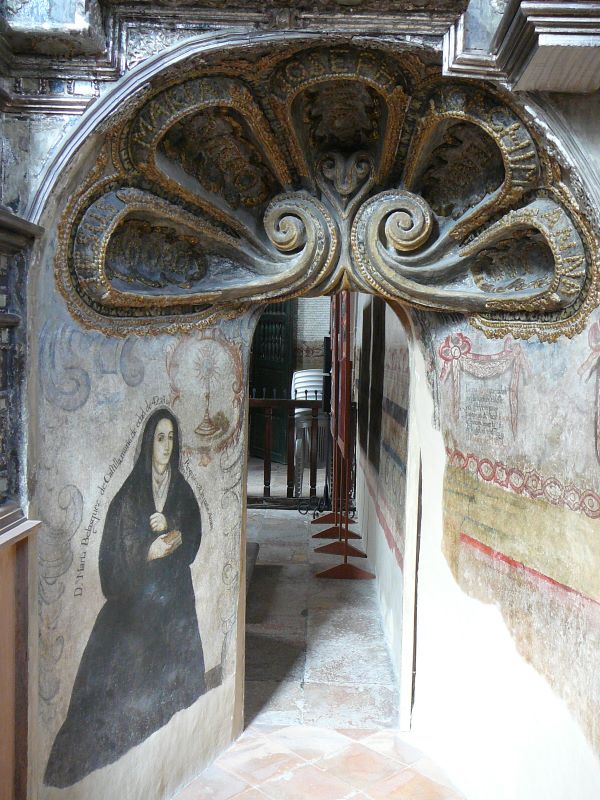
...and the doorways. The woman depicted by Martinez de
Pocasangre at left, is the mother of Father Alfaro. His
father's picture also graces the walls of this camarin.
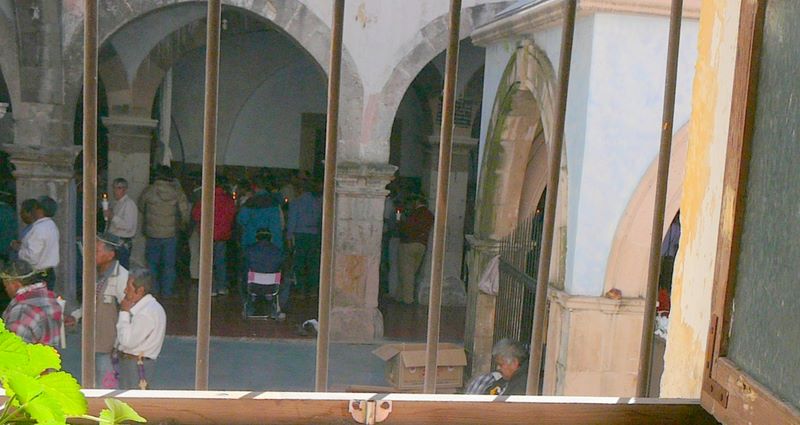
I snuck this picture through the sacristy window looking across a courtyard into the arcaded retreat house. Tourists are not allowed into the cloistered area which houses those making week-long retreats partially based upon the Spiritual Exercises of St. Ignatius and partially on self-flagellation and the wearing of the crown of thorns.
Although about 75,000 people a year make these week-long retreats, 1500 to 3000 at a time, they are invisible to the tourists and their cameras. Like Padre Alfaro himself, there is nothing sensational here. Men (11 sessions) and women (19 sessions) take separate weeks so Father Alfaro won't have to worry any more about departures from chastity.[24] Children outside the church sell whips (really just but colorful ropes with knotted ends called disciplinas.) Booths sell crowns of thorns made from the mesquite in plentiful supply here. Here, not just the Rosaries have their mysteries.
A replica of Father Hidalgo's Banner sitting in the Shrine's sacristy
The Shrine has quite a history in the military crises that plagued Mexico. Its location between two significant towns of the War of Independence made it a place for revolutionaries to catch their breath. After all, the Shrine is here because Padre Alfaro stopped here to rest when returning to San Miguel after preaching in Dolores. This was a quiet place then; Alfaro slept and dreamed of Christ crowned with thorns telling him to build a place for penitence here.About 70 years later, another priest stopped here in less placid times. The champion of the downtrodden, Father Miguel Hidalgo y Costilla, after issuing the Grito de Delores (the battle cry of the war of independence), paused here with his mob in September 1810; they appropriated the banner of the Virgin of Guadalupe to lead them through the mayhem of the next several months.[25] The original banner, considered to be the first Mexican coat of arms, rests at the Mexican Museum of History in the capital.
Other soldiers have been less respectful Padre Alfaro's place of penance. During the decade of the War of Independence (1810-1820), rebels hid here between attacks on the king's silver trains. A century later during the Revolution of 1910, troops seized the shrine and stabled their horses inside following Napoleon's example. [103]Behind the main altar of the nave is another camarin. (See its
ceiling at the very top of this page or by clicking on the thumbnail at
right). Padre Alfaro called this the Camarin of the Glory as he thought the light at the top of the dome represented the glory of God streaming down Pentacostal-like on the Apostles.[17]
thought the light at the top of the dome represented the glory of God streaming down Pentacostal-like on the Apostles.[17]
This camarin presents a circle formed by Mary and the 12 apostles. Above each statue is the religious symbol of the shell. Above we see (left to right): Matthew, Bartholomew, and James the Greater (whose symbol is, of course, the shell).
Here's a typical segment of the circle of Apostles. Above each statue and its shell is a picture from the life of that saint. There's a bit of architectural trickery as this space lies under and octagonal dome but holds statues of the twelve Apostles.
Above is a view with humans meant to give the reader a sense of scale.
St Andrew with his cross --in both statue and picture.
The back lot show ruins of a much larger (but now crumbling) complex. In the 1990s, The World Monuments Fund included this site on its list of endangered spots. Since then, the remaining buildings have been stabilized and restoration of the wall-to-wall murals of the interior have preserved much of the folk art. External murals, however, are pretty much gone except for a few traces.
See more pictures of the exterior of this shrine by clicking here.
Mexicans are rightfully proud of this Shrine. We saw buses bring hordes of bored school kids in to see the place and photograph it with their cell phones. Unbeknownst to them, a few yards away kneel hundreds of penitents making a week long retreat under the rule laid out by Ignatius of Loyola 500 years ago. Around both this old and new Mexico swirl curious travelers such as ourselves from far places in various states of disbelief.
Return to our San Miguel de Allende overview page by clicking here.
Geek and Legal StuffPlease allow JavaScript to enable word definitions. This page has been tested in Internet Explorer 7.0 and Firefox 2.0. Created April 2008 |
 |
Overview of San Miguel
Churches of San Miguel
Oases of Green
Culture